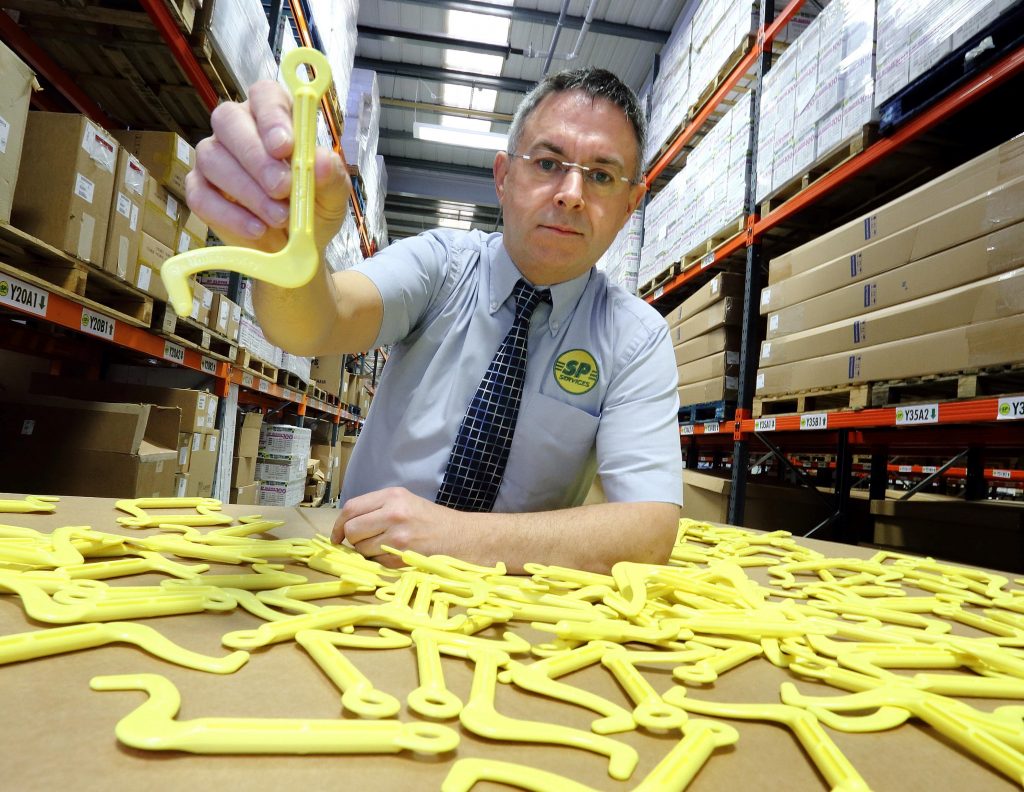|
|
World first 2GW network of batteries and rapid charging stations planned
Pivot Power today unveiled plans to build a world-first 2GW network of grid-scale batteries and rapid electric vehicle (EV) charging stations across the UK.
The £1.6 billion programme will provide infrastructure to support the rapid adoption of EVs and underpin clean air policies, while introducing valuable flexibility into the energy system to accommodate the demands of mass EV charging and higher levels of intermittent renewable generation.
Pivot Power plans to develop 45 sites around the country, installing grid-scale 50MW batteries at electricity sub-stations connected directly to the extra-high-voltage transmission system. These will give the electricity system operator National Grid a huge resource in managing supply and demand.
The battery network will be the world’s biggest, storing enough electricity to supply 235,000 average homes for a day. It will have the ability to release or absorb two thirds the power of the planned Hinkley C nuclear power plant in response to grid balancing requirements.
Sites have been chosen near towns and major roads where they can also power rapid EV charging stations. These will be fed directly by the transmission system, and so will be able to offer mass charging at competitive rates, supporting up to 100 rapid 150KW chargers. They will also be able to support rapid 350KW chargers when they are available in the UK.
It will also be the world’s largest network of rapid charging stations, addressing the three biggest barriers to EV adoption identified by the Department for Transport: availability of chargers, distance travelled on a charge, and cost.[1] By offering affordable charging it will also lower the costs of car ownership for the next generation, the third biggest barrier.
Graeme Cooper, National Grid Project Director for Electric Vehicles, said: “We expect the use of electric vehicles to grow rapidly. This innovative solution will help accelerate adoption by providing a network of rapid charging stations across the country enabling cars to charge quickly, efficiently and as cost-effectively as possible.
“It will also give the system operator more choice and flexibility for managing the demands in the day to day running of the network, and also help mass EV charging”.
Pivot Power aims to have operational batteries at 10 sites within 18 months. Each will provide a hub that can support a variety of infrastructure such as public rapid charging stations, electric bus depots and bases for large transport fleets. A site on the south coast could be operational by the middle of 2019, subject to planning approval, and more details will be announced in the coming months.
CEO Matt Allen said: “We want to future-proof the UK’s energy system and accelerate the electric vehicle revolution, helping the UK to clean up its air and meet climate targets. Big problems require big solutions, and we are moving fast to put in place a unique network to support a clean, affordable, secure energy system and embrace the low-carbon economy.
“We are keen to hear from anyone who shares our vision and wants to ‘go electric’, particularly partners with large fleets such as local authorities, supermarkets and logistics companies.”
Pivot Power has financial backing from Downing LLP, a UK-based investment manager which has funded over 100 deals into renewable energy investments since 2010, totalling more than £500 million. Pivot Power is already in talks with institutional and strategic investors, and potential partners, such as car manufacturers, charging providers, and technology and energy companies.
Downing has provided financial support for the initial phase of the project and plans to provide further funding as the rollout of rapid charging stations progresses. Members of the public including EV drivers will have the opportunity to invest alongside institutional investors through the Downing Crowd platform.
Colin Corbally, Partner at Downing LLP, said: “The prospects of a future ban on petrol and diesel vehicles, coupled with the threat of a potential energy crisis in the UK, mean Pivot Power is extremely well-positioned to help UK investors benefit from supporting the low-carbon transition. Through our partnership with the Pivot Power team, we have developed an exciting but robust business plan to seize this unique opportunity to play a pivotal role in the battery and electric car revolution.”
Michael Liebreich, founder of Bloomberg New Energy Finance, an advisor and investor in Pivot Power, said: “Renewables, batteries and electric vehicles are going to completely transform our power system, not just because they help clean up our horrible air quality and meet our climate targets, but because their costs are falling far faster than people realise. Pivot Power were quick to understand the scale and nature of the opportunity and have positioned themselves brilliantly.”
The core of Pivot Power’s strategy is connecting batteries and rapid charging stations directly to the extra-high-voltage transmission system. This will give it a competitive advantage over existing batteries and charging stations linked to the lower voltage regional distribution system.
- It will be able to buy power at lower cost and it is committed to keeping prices as low as possible for drivers.
- Its rapid charging stations will have access to abundant power – each will have a 20MW connection, enough to supply a town of 10,000 homes.
- Combining batteries with EV charging maximises the value from each grid connection, and economies of scale should drive down building and operating costs.
Each site offers a range of revenue streams. The batteries will earn money from providing a range of services to National Grid, from sales of electricity to chargers, and from energy trading. They could also potentially provide services to energy-intensive industries. Rapid charging stations will earn income from EV drivers.
Pivot Power has assembled a high-calibre team with the specialist planning, financing, development and management skills to build this business. It was founded and is led by:
-
- Matthew Allen, Chief Executive Officer. Previous experience as Global Commercial Head, Bloomberg New Energy Finance; Director at Good Energy; Chief Commercial Officer at Tempus Energy.
- Michael Clark, Chief Technical Officer. Previous experience as Head of Network Optimisation, Tempus Energy; Low Carbon London Programme Director, UK Power Networks; Principal Electrical Engineer at Engineering Services Partnership.
- Matthew Boulton, Chief Operating Officer. Previous experience as COO at Solarcentury and European Supply Chain Director at Sony Electronics.
[1] Public attitudes towards electric vehicles: 2016 (revised), Department for Transport.
 Paul Parker: SolarWinds Chief Technologist for Public Sector Cloud and hybrid IT will be one of the top five most important technologies for U.K. public sector IT professionals in the next three to five years. This is the view held by 88% of the industry surveyed in the SolarWinds IT Trends Report 2018. Further insights from the report uncover that, even with challenges implementing cloud services, the sector remains positive about the opportunities the cloud presents, both today and in the near future.
Despite cloud and hybrid IT representing one of the top challenges in rollout and performance (with 62% of respondents ranking it in the top three challenges), the public sector continues to see the benefits of the cloud, primarily for creating efficiencies (72%*), ROI (81%*) and productivity (79%*).
Barriers to success
At the same time, over half (58%) of public sector respondents say their IT systems are not performing at optimum levels, and a further quarter (23%) are not sure. Three quarters (73%) of public sector IT professionals spend more than 25% of their time reactively working to optimise performance, while just 47% spend a similar amount of time proactively optimising. When asked what was causing barriers to performance, nearly half (44%) cite inadequate infrastructure, while a staggering 56% cite a lack of organisational strategy.
“With these results, we see continued public sector commitment to the cloud and hybrid IT,” commented Paul Parker, chief technologist of federal and national government, SolarWinds. “However, what is most striking for me is the amount of time IT professionals spend retroactively fixing their systems. I would liken it to trying to fix a car as you drive it down the motorway – trying to maintain systems while they are still in use is near impossible, and ineffective in the long run. Without having the time, strategy and budget to get core systems working first, it is no surprise that public sector entities are taking longer to adopt and benefit from the Government’s Cloud First policy than perhaps was originally hoped.”
The promise of emerging technologies
Alongside their focus on the cloud, public sector respondents also voice interest in emerging technologies. While automation and AI prove more popular among for-profit organisations than the public sector, there is still strong interest in embracing these advances. Over half (56%) rate automation as a top three technology with the greatest potential of improving productivity and efficiency, and a third (33%) see the same potential in AI.
When it comes to Software Defined Everything (SDx) and big data analytics, the public sector is more optimistic than its for-profit counterparts; over half (56%) of public sector respondents think SDx is one of the top three technologies in terms of ROI potential, while a similar percentage (51%) rank big data analytics among the top three technologies with the greatest potential to provide productivity and efficiency benefits. This is compared to equivalent responses from for-profit organisations, where just 17% rate SDx, and 34% rate big data analytics similarly.
Further findings from the research are as follows:
- 77% of public sector respondents think the cloud is the most important technology in their IT strategy today, compared to 62% of U.K. for-profit organisations
- 72% of public sector respondents consider the cloud to be one of the top three technologies for creating and increasing efficiencies, and 79% consider it among the top three in terms of productivity benefits
- In the next 3-5 years, the public sector expects AI to be one of the top five most important technologies in their strategy, according to 51% of respondents
- 81% rate cloud and hybrid IT as one of the top three technologies in terms of ROI potential, compared to just 60% of for-profit organisations
*percentage of U.K. public sector respondents who rated the cloud as one of the top three technologies with the greatest potential in these areas
The SolarWinds IT Trends Report is now live: IT Trends Index
 Paul Worrall, Founder, Zonafide Blockchain. Bitcoin. Cryptocurrency. These are just some of the buzz words that have been seen widespread usage on the front pages of mainstream media in recent months. Despite the increasing noise around these terms, the practical applications and uses of them has been hotly debated.
Within this context, few are talking about how the public sector fits into this equation and how this technology can bring new opportunities to provide value and generate revenue from existing public services.
At Zonafide we see significant scope for public sector organisations to embrace blockchain technology and are excited about the future having already developed a first use case with Local Government Register Services.
Zonafide: a Digital Wallet leveraging blockchain and collaboration technology to ensure a person’s Activities are secure from fraud and cybercrime
In 2013 after we and people within our wider community experienced various forms of identity theft. I started thinking more closely about how people share their personal information and how they had to interact with organisations and companies around this sensitive data.
It was also clear that this was a growing and increasingly costly problem. According to the ONS, there were a staggering 6 million fraud and cybercrimes in England and Wales in 2015/16 with a total cost of £11 billion to the UK economy. Moreover, this trend showed no sign of abating with the cost implications for individuals, companies and organisations set to rocket further.
Looking at this growing phenomenon it was evident that the current relationship and the principle of trust between individuals and organisations needed to be readdressed.
Historically, different organisations have different ways to identify people making it harder for customers to manage their credentials. Verification processes are fractious and inefficient in and between organisations, as well as the fact people have to trust organisations to secure their information. Evidently, from the number of data breaches and cyberattacks this is proving hard for organisations to do – the case of Equifax and the breach of 143 million consumer’s data being one of the most high profile recent cases.
In short, legacy technology and centralized systems are vulnerable to attack and aren’t able to guarantee the job they set out to do.
In response to this issue and drawing upon my thirty years of experience in software development and distributed computing in investment banking, we have developed a digital wallet to help users secure Activities and take back control of their personal information – we call it being self-sovereign.
 An Activity is something important people are doing, such as a house purchase payment or changing credit limits with a bank and takes the form of an Ethereum-based smart contract. By using a digital wallet, users can securely share their Activities to prove they’re legitimate. An Activity is something important people are doing, such as a house purchase payment or changing credit limits with a bank and takes the form of an Ethereum-based smart contract. By using a digital wallet, users can securely share their Activities to prove they’re legitimate.
In addition, as the blockchain network is decentralised, it avoids the inflexibility, inefficiencies, costs and weaknesses embedded in centralised systems.
The public sector and blockchain: opportunities to provide value and generate revenue. So how does Zonafide and its blockchain based technology fit with the public sector?
We have identified and developed a first use case with Local Government Registers Services for life events, such as births, deaths and marriages.
Specifically, we have developed a Newlywed Name Change Service where Registrars can help couples looking to change their name do so efficiently and securely. No longer does a recent bride or groom who needs to change their name with multiple service providers – think utility services, banks, insurers – have to go through the laborious and time intensive process of contacting them separately, sending off different paper work and having to follow their different verification process. Through the Zonafide app, this can be achieved through a few simple taps.
With over 262,000 marriages across England and Wales annually (87% of which are performed by Register Services), this is a significant market. The wider births, deaths and life events market is also worth £600m a year, so again this one application has significant market opportunity.
We currently have Letters of Intent from four London Boroughs for the Newlywed Name Change Service. As part of their onboarding, we have also been the first private sector organisation to train public officials on a specific blockchain-based product and its benefits. Through Zonafide, there’s also the potential for Local Authorities to grow new revenue streams. Within the Zonafide ecosystem one of the key roles are the Authoritative Acknowledger Oracles (‘Oracles’). Oracles are specialists in their domain, for example in the Newlywed Name Change Service, and are responsible for onboarding the necessary parties to ensure an Activity is authoritatively Acknowledged. Oracles charge for this service, thereby earning revenue from playing a role within the Zonafide ecosystem.
Our ambition is to take this initial use case to councils across England and Wales, which collectively would translate into significant new revenue for authorities throughout the country.
Beyond Register Services the opportunities for adopting blockchain in the public sector are vast. From the NHS handling sensitive patient information, submitting planning applications to preventing electoral fraud and applying for a new passport, everywhere you look there are opportunities to make processes that involve the public sector organisations and individuals more secure and frictionless.
In particular, there is also the benefit with Zonafide for supporting vulnerable people, as they often need greater protection when navigating important transactions. By including family members in the Activity verification process, it will help add an extra layer of protection to ensure vulnerable people are not the victims of fraud and that potentially life changing actions don’t happen unless they are meant to.
The public sector and blockchain: the future
A few years from now I envisage blockchain technology being integrated with processes across both the private and public sector. However, the truth is that the technology and importantly, viable applications, are here now.
As Zonafide and its Newlywed Name Change Service shows, blockchain could provide the public sector with many opportunities for value creation and increased revenue from existing services.
By Paul Worrall, Founder, Zonafide
About Zonafide
Zonafide is a Digital Wallet that leverages blockchain and collaboration technology to ensure Activities are secure and legitimate. An Activity is something important that an individual carries out, for example, a house purchase or changing credit limits with a bank. Zonafide is one of the first business uses of blockchain technology and is designed to empower people to protect themselves from cybercrime and fraud.
Zonafide’s first use case is with Local Government Register Services for life events (births, deaths and marriages) which represents a market opportunity of c.600 million. The founder, Paul Worrall, has over 30 years’ experience in distributed computing and software development in investment banking.
For more information, please visit: www.zonafide.net/
 Reporter: Stuart Littleford Reporter: Stuart Littleford
Following the news that Wigan County Council have experienced more than 80 data breaches in the past 2 years, the council has reinforced the importance of data security to all its staff.
Brendan Whitworth, assistant director for legal services at Wigan Council told GPSJ: “Information security is a high priority for Wigan Council.
“When a data loss happens, officers from internal audit work with the council’s data protection officer to ensure the breach is properly investigated, that adequate remedial action is taken (including disciplinary action if required) and lessons learned are communicated widely.
 Jon Fielding, Managing Director, EMEA Apricorn “We continue to reinforce the importance of data security to all our staff with relevant training to support this.”
Jon Fielding, Managing Director, EMEA Apricorn told GPSJ today: “80 breaches over 2 years is significant and is rightly of concern to the council. However, in their defence, they have recognised this fact and are taking action in conjunction with their Data Protection Officer.
“This also tells me that the council is aware of, and taking steps to be complaint with the upcoming GDPR regulations that will require compliance in 2 months.
“They have caught the issue at the right time, i.e. before GDPR is in force, and I would encourage all businesses, whether they are in the public or private sector, to do the same.”
For more information on Apricorn please visit: www.apricorn.com/GDPR
Reporter: Stuart Littleford
Zonafide, the mobile app leveraging blockchain and collaboration technology to ensure Activities are secure and legitimate, today announces a partnership with Atos to help combat identity theft and cybercrime.
The partnership will see Atos assist their clients in the use of Zonafide’s blockchain-based technology in order to drive efficiencies and improve security when processing life events such as marriage and deaths. Atos’ clients span all major industries and sectors, including £3 billion of UK Government contracts ranging from the NS&I to the BBC.
Zonafide helps prevent fraud and cybercrime by securing Activities – an important transaction such as a house purchase payment or updating personal details with a bank – using blockchain technology. Ultimately, Zonafide prevents things happening unless the individual wants them to, ensuring that Activities are secure and legitimate.
As well as helping fight identity theft and cybercrime, Zonafide reduces the friction in verifying transactions and increases efficiency.
Moreover, as Zonafide’s blockchain network is decentralised it avoids the inflexibility, costs and weaknesses embedded in centralised systems. All these advantages look set to benefit Atos’ clients who adopt Zonafide and its technology.
Commenting on the partnership, Paul Worrall, Founder of Zonafide said: “This is a landmark partnership for Zonafide. Atos provides our clients with the confidence that our blockchain-based solution has the commitment of established IT services companies. This partnership is also a recognition of the power of blockchain to disrupt traditional processes and legacy centralised systems currently used by most organisations.
“Whilst Zonafide will initially be used in Activities relating to life events in Register Services in UK Local Government, there are many more potential applications that we look forward to working with Atos on.”
Ivo Luijendijk, Group Industry Director Data Analytics, IOT & Blockchain at Atos added: “Discussions with Zonafide have been greatly appreciated by our clients and we have already identified a prospect. I think this will be a fruitful partnership for both Atos and Zonafide.”
In addition to providing Zonafide’s software, the firm’s founders will also be hosting blockchain-focused workshops with Atos’ senior management, to further embed their knowledge of the technology’s potential and to discuss commercial opportunities.
 Joseph Blass, CEO, WorkPlaceLive By Joseph Blass, CEO, WorkPlaceLive
Voice over IP, often known as VoIP, may no longer be a new story. Pioneered nearly 20 years ago and made famous by Skype, there are now many providers of this service which allows you to “speak over the internet”, with the quality of the calls and pricing packages making it a real contender for organisation-wide telecom solutions.
VoIP is a cornerstone of cloud-based Unified Communications [UC] which is changing how we work – and even holiday, for those who need to stay in touch when on a break. Many of us do. We also need to work away from the office at times; i.e. not just when on holiday.
UC is a descriptive term for integrated enterprise communication services: VoIP telephony, email, call control, instant messaging/chat and conferencing.
UC really scores when it’s combined with IT, especially when accessed via common hosted desktops. What this means in practice is that employees can work regardless of where they are based. All they require is an internet connection and access device [tablet, laptop, smartphone etc].
In the public sector, a solution like UC combined with IT should be at the centre of all processes, bringing together teams, enabling collaboration and offering scalability and integration with existing systems. In this sector, where procedure and process is necessarily stringent and time consuming – and price paramount – getting it right, including being able to work with trusted suppliers, is key.
The first step is to work with a UC provider who can offer you the best solution for your organisation’s needs and not just the solution that they can provide.
Bespoke services like VoIP can be designed to a precise need, but changes in IT can feel like a daunting move, in part because of the immense possibilities offered. So, when considering a move from the more traditional landline-based communcations services provider, how can you differentiate between the competitors in front of you?
The answer to this is two-fold.
First, you can look at how a “standard” package compares from one supplier to another. One supplier’s “Standard” may not be the same as that of another. Consider the service, particularly functionality at basic package level, support, call quality and price. Can you get a testimonial from a current customer? Has the provider achieved accreditations to prove service standards? These headline questions will help you to whittle down your first tranche of possibilities.
Secondly though, what can really make a provider different from its competitors is when it can not only solve your telecom requirements but potentially unify all of your business IT, allowing an experience greatly superior to your current arrangements.
An enterprise solution will increase available functionality and combine all the benefits of a traditional system as well as all the benefits of a cloud-based phone and IT service.
Most organisations have dipped their proverbial toes into the cloud-based IT waters but what comes next is increasing the efficiencies they have already began to discover by allowing them to connect and integrate.
A great VoIP provider will enable your organisation to unify your IT system alongside your cloud-based phone service thus unlocking the benefits, functionality and efficiencies available from integrating those services. They will see past the standalone positives of VoIP and offer access to increased positives by allowing the solutions to work together for the benefit of your staff and working environment.
Hosted desktops (aka virtual desktops/Desktops as a Service) take your usual desktop experience into the cloud and allow your organisation flexible, secure access to all of its usual office data and software. “Working from anywhere” becomes a possibility. When you bring VoIP into the equation, employees, contractors or volunteers can login to their desktop and, using either a physical handset or “soft phone”, continue using their telephony in the same way, regardless of their location.
An extension number will connect to your mobile and follow you around without the caller needing to know you are not at your usual office location. User to user calling becomes free. One click calling via the desktop comes into play. The VoIP solution is a flexible reply to a need to work in a more flexible way than traditional services have allowed or, a sophisticated handset at your desk in the office, as you wish.
The insinuation here is that you should never be away from your day job. However, where you don’t want to incur roaming costs while abroad, or a contact to know that you are out of the office, the flexibility offered is clear.
Here’s how it can work
Consider you wanted to talk to a caller whilst away from your usual office desk. VoIP will allow you to take the call as if you were. Then, if your caller has questions about a specific subject, your hosted desktop will allow you to access all relevant spreadsheets, CRM or existing files without the need for apologies or excuses. Essentially, the unified communications will offer you a choice, never available with your previous non-hosted solutions.
This second comparison measurement, a step forward from the basic “cost” questions, is where you can truly identify whether you can go forward with VoIP or unified communications; where all your efficiencies are heightened.
The plethora of VoIP providers in the system (or on your shortlist) can be further reduced when you assess their capacity to answer just one of the possibilities available by internet telecoms or the complete range. It is worth considering whether a move to VoIP is good enough when technology has already moved past that and can offer so much more, and where VoIP is a cornerstone, not just a standalone.
That’s where UC, combined with IT in the cloud, comes into its own.
More at www.workplacelive.com
 SP Services MD Steve Bray with the new Tourni-key Reporter: Stuart Littleford
A UK medical supplier is supporting a nationwide campaign to save lives after a terrorist attack.
SP Services, of Telford, is ready to supply thousands of newly designed lightweight tourniquets for use in public places in the event of a bomb, shooting or knife attack.
The medical equipment has been specifically designed for people without medical experience by Brigadier Tim Hodgetts CBE, a surgeon who has worked in multiple war zones and is renowned for his innovations in dealing with combat injuries.
The brigadier, who served as the Queen’s Honorary Physician for six years, has accolades galore for his distinguished medical career which includes advising the Government as Medical Director of the Defence Medical Services.
Passionate about medical education, he helped set up the citizenAID charity to empower everyday people not to panic after a terrorist attack but to “know what to do” to save lives.
“He is a quite remarkable man and SP Services is very proud indeed to have been chosen as the sole distributor to work with citizenAID to supply medical equipment to public organisations,” said MD Steve Bray, who also supplies medical and humanitarian equipment to war zones and is a major supplier to the NHS and MOD.
The brigadier said: “Experience has taught us there is a predictable delay between an attack taking place and professional help reaching the injured. This means those within the incident, the public, are the ones who can make the difference in saving life from severe bleeding.
“Its unique design allows the tourniquet to be quickly secured. As a low-cost alternative, there is a realistic opportunity to make this life saving skill more widely available and to empower a critical mass of the public and first responders.”
The lightweight Tourni-Key is a 13cm long yellow plastic tool with a small hole at one end and a hook at the other. It enables the user to quickly apply pressure and stop profuse bleeding which can kill victims very quickly.
 Brigadier Tim Hodgetts CBE Security guards, shopping mall staff, event stewards and other public event organisers can quickly learn how to use the device with a tie, scarf or triangular bandage to help save lives of people bleeding severely from a wound to the arms or legs after a deliberate attack.
In the US, a tourniquet saved the life of country music lover Daisy Bautista (39) who was caught up in the Las Vegas shooting in October last year.
Controversy has surrounded its use in recent years with the belief that the injured can lose a limb if a tourniquet is applied wrongly by the untrained.
But more than 200,000 US police officers were trained to use it after the mass murder of schoolchildren at Sandy Hook in 2012 and they are now commonly available in shopping malls and airports next to defibrillators.
citizenAID has developed a free app giving the public advice on what to do in the event of a terrorist attack. The new Tourni-Key is available from SP Services (UK) Ltd, Hortonwood 30, Telford, Shropshire, or online www.spservices.co.uk/tourni-key
Brigadier Tim Hodgetts demonstrates to Steve Bray how the Tourni-key works www.spservices.co.uk/item/citizenAID_NEWTourni-KeywithAnti-PinchCard_205_107_6149_1.html
and talks about citizenAID here: vimeo.com/190709838
 Jon Fielding, Managing Director, EMEA Apricorn By Jon Fielding, Managing Director, EMEA Apricorn
As the General Data Protection Regulation (GDPR) deadline looms, organisations are scrambling to find all potential vulnerabilities that could lead to sensitive data being lost or exploited. GDPR will ensure all countries comply with the same comprehensive controls over the personal data of European citizens, applying a consistent level of security and protection wherever it is processed. The new regulation is set to push organisations into taking appropriate steps to protect the data they house. Should a company be found in breach of GDPR, it could be subject to fines of 4 per cent of its annual global turnover or €20 million, whichever is greater.
Human Error
Organisations are investing heavily in new cyber security tools, adopting the latest software and threat intelligence in order to comply with the new legislation and avoid the consequences of a data breach. However, even with the greatest security systems in place, one of the biggest threats to intellectual property comes from the user and the risks posed by human error.
Human beings are typically the weakest link when it comes to data security. In a survey carried out by Apricorn, 48 per cent of companies said employees are their biggest security risk, and as many as 44 per cent expect that employees will lose data and expose their organisation to the risk of a data breach.
Human error and poor practice, such as PCs left unlocked or someone clicking on a malware-infected link in an email, can all lead to an attack and, ultimately, a serious data breach. Add to that the increase in employees using personal storage devices – such as USB memory sticks, smart phones, and tablets – and the potential to remove or copy sensitive information outside the corporate network has become a growing risk. The proliferation of mobile and removable devices has blurred the corporate boundaries, but GDPR requires that organisations should be able to trace all personal data and understand where it resides and how it’s used.
Organisations will need to document exactly what data collected and how it is processed, stored, retrieved and deleted through its lifecycle to pinpoint where data may be unprotected and/or at risk. Currently, however, 38 percent of surveyed organisations believe they have no control over where company data goes and where it is stored. This suggests a lack of policy and control over their data.
Policy and Education
The pivotal component of any organisation’s GDPR compliance framework is employee awareness and education. Employees at all levels must understand the critical importance of their organisation’s data and the need to comply with corporate security policy. Increased training and testing is key in educating employees about their responsibilities and their role in protecting sensitive information.
First of all, appropriate policies should be created and enforced. However, if employees do not recognise and understand the legislation and its consequences, the likelihood is that failings will ensue.
Corporate processes and policies aren’t always easy to implement and follow, and it’s impossible to secure against all lines of attack. Policies can be ignored, and advice disregarded, but with the right technology and education in place, businesses can reduce the potential impact and minimise the risks.
As part of the new GDPR requirements, organisations must demonstrate that authorisation and access to certain intellectual data and sensitive information is limited. They must be able to demonstrate who has access to information and the reasons why, whilst considering how data is protected outside of their central systems, both on the move and at rest.
To avoid the potential for human error when data is being transferred outside of the network or between systems, organisations need to research, identify and mandate a corporate-standard encrypted mobile storage device. In addition, the use of the device should be enforced across the organisation through policies – such as locking down USB ports so they can accept only approved devices. These processes will then enable organisations to identify shortcomings in their technologies and policies and provides a simple step toward GDPR compliance.
In fact, an organisation’s biggest liability within GDPR is at the point of breach and deploying encryption for mobile devices is a simple and quick win. GDPR is generally non-prescriptive in terms of technology and the implementation of processes, policies and procedures is left to each business. However, Article 32 requires “the pseudonymisation and encryption of personal data”. Article 34 notes that, in the event of a breach if the data involved is encrypted, there isn’t a requirement to contact each individual affected, thereby avoiding the resultant administrative costs.
Human error is one threat to non-compliance, but GDPR imposes many different standards for data protection and it is an organisation’s responsibility to demonstrate how they are complying with each of the principles.
Among other action points, organisations should prioritise the following in their strategy:
- Ensure up to date security systems are in place, particularly encryption and authentication technologies. This should include implementing appropriate monitoring and controls to evidence GDPR compliance.
- Develop defined organisational policies and procedures covering how data is captured, processed, managed and disposed of, and check regularly that these are complied with.
- Ensure processes are in place to manage the rights GDPR bestows upon the citizen – the right to be forgotten, the right to receive data in a portable format, and explicit consent and understanding for the collection of data, etc.
- Ensure employees receive training on the cybersecurity policy and when to report incidents.
- Restrict access to personal data only to those who need it.
Organisations should see GDPR not as a threat, but instead, use it as an opportunity to batten down the hatches and ensure their data is secure through best practices.
For further information, and a special offer of a device to test for FREE, please visit: www.apricorn.com/gdpr/gpsj
NetCloud Service Includes New Ruggedised IBR1700 Router, Combining Enterprise-Class Management, Security and SD-WAN Functionality with Fleet Management Capabilities
Cradlepoint, the global leader in cloud-delivered 4G LTE network solutions that provide a pathway to 5G, today announced a solution package for its NetCloud service that includes the new IBR1700 mobile router. The new NetCloud Solution Package for Mobile brings the benefits of software-defined wide-area networking (WAN) to first responders, transit operators, and other field force and fleet-based organisations that rely on simple-to-manage, reliable, and secure in-vehicle and mobile networks with always-on 4G LTE connectivity. Today’s announcement is the third since Jan. 16, 2018, that introduces Cradlepoint NetCloud Solution Packages for new router endpoints for branch, mobile or IoT networking.
First responders and related organisations that depend on distributed field forces and fleets to provide products and services need reliable and secure mobile networks with always-on 4G LTE connectivity. Their people and passengers must have access to mission-critical applications and the Internet from anywhere – with data flowing from onboard telemetry, sensors, surveillance cameras and other devices. However, managing and securing roving communications hubs is a challenge for IT teams as traditional mobile solutions fail to provide enterprise-class visibility, security and control capabilities of fixed branch networks.
“Cloud, mobile computing, IoT, and 4G/5G wireless technologies are converging to create new solutions that improve the productivity, safety, and management of field workforces and fleet operations – including public safety, field service, utility, and transportation organisations,” said Lee Doyle, Principal Analyst at Doyle Research. “The resulting proliferation of mobile networks will stretch IT teams as they seek to replicate the reliability, security, and management attributes of their branch networks, making the wireless WAN the next frontier for SD-WAN technologies.”
The new Cradlepoint NetCloud Solution Package features the company’s newest ruggedised, all-in-one mobile router – the IBR1700. This new package, delivered as a service, combines the enterprise networking, security and management features that IT teams demand – including SD-WAN for LTE – with the Automated Vehicle Location (AVL) and telematics capabilities required by fleet managers.
Purpose-Build, All-in-One Mobile Solution Delivered As-A-Service
Designed to withstand extreme environments, the IBR1700 replaces multiple standalone boxes with an all-in-one mobile networking solution ideally suited for installations within a wide range of vehicles, including police, fire, ambulance, and other first responder vehicles such school and metro transit buses, light-rail and commuter trains or mobile command trailers. The IBR1700 comes standard with the following networking features:
- Integrated 600Mpbs LTE Advanced modem and optional, field-installable modem
- Five WAN/LAN switchable Gigabit Ethernet ports
- Advanced 802.11ac Wave 2 WiFi
Built-in fleet management features enable a wide range of location-based and telematics applications, such as AVL, asset tracking with geofencing, safe driving programs and proactive vehicle maintenance:
- Active GPS with dead reckoning
- ODB-II port connection
- Ignition-sensing
- Multiple General Purpose I/O (GPIO) ports
NetCloud Perimeter is included in the base package and uses Software-defined Perimeter technology to provide secure and persistent connections for in-vehicle IoT devices, such as sensors, cameras, PoS terminals and digital signage.
Cradlepoint’s all-inclusive NetCloud Solution Packages are delivered as a service and simplify the way customers buy, deploy, manage and evolve their edge networks, facilitating rapid deployment, time-to-value and customer success. Each package is tailored to the needs of branch, mobile or IoT networking, and combines NetCloud services, purpose-built hardware with a lifetime warranty, and comprehensive 24×7 support in to a single 1-, 3-, or 5-year subscription. The new mobile solution packages provide cloud management, SD-WAN functionality that dynamically steers traffic between two active 4G LTE cellular networks for optimal performance in all conditions, as well as unified Internet security with firewall, IPS/IDS and web filtering with pricing starting at $1,199.
“For many fleet-based organisations, their cars, trucks, buses, trains, and boats are essentially roving branches that share many of the same IT challenges as fixed sites in terms of reliability, security and management,” said Todd Krautkremer, CMO at Cradlepoint. “Cradlepoint is the first to extend the benefits of SD-WAN to these mobile networks, making it quick and easy for IT teams to always keep their field forces connected, secured, and productive – and their fleet managers in control – without adding more staff or more hours in their day.”
To find out more, visit cradlepoint.com/mobile-networks
 Reporter: Steve Harrison Reporter: Steve Harrison
The London Grid for Learning (LGfL) has announced Cyber Protect, its ambitious and ground breaking initiative to create an online Centre of Excellence for Cyber Security for schools. The new centre, which will sit within LGfL’s existing site, will provide the best possible protection from increasingly complex and sophisticated cyber threats.
LGfL is acutely aware of the security risks posed to schools by criminals on the web. It is LGfL’s passion for protecting schools which led LGfL to commission its own dedicated fibre network, LGfL 2.0, for use with schools, designed to provide defence in depth through multiple layers of security and the delivery of one of the largest IP VPN networks for education in the world.
The new Cyber Security Centre for education will work with schools across LGfL’s grid to keep them safe through collaboration, threat management and partnerships with industry and government leaders.
As part of its new mandate LGfL will harness its scale to deliver ground breaking products to schools as part of its managed service offer. This includes InterceptX and Malwarebytes which are being provided free to London schools. The new Centre of Excellence will complement the pioneering work underway in LGfL on online safety where LGfL has established successful partnerships with ChildNet, the Internet Watch Foundation and more recently the NSPCC.
John Jackson, Chief Executive Officer at the London Grid for Learning told GPSJ: “LGfL and our partners have always shared a passion for security and keeping children safe. The rise in the frequency and complexity of security incidents on the internet has convinced LGfL that it is vital that we do all we can to proactively protect schools and ensure our children’s education is not interrupted. I am delighted that LGfL has made this a priority and I’m sure the schools we support will feel the same way.”
To find out more about Cyber Protect, please visit www.lgfl.net/cyberprotect/.
 Reporter: Stuart Littleford Reporter: Stuart Littleford
The Chartered Institute of Journalists is urging the government to keep its nerve in stopping local authorities in Waltham Forest and Hackney from publishing ‘Pravda’ style propaganda newspapers.
Both councils have persuaded the Ministry of Housing, Communities and Local Government to postpone a final deadline of closure that had been set for Tuesday February 6th on their fortnightly Waltham Forest News and Hackney Today newsletters.
Janice Shillum Bhend, who is to become President of the Institute in March, has played a leading role in campaigning against councils publishing PR papers full of their own press releases and political spin.
Speaking to GPSJ Janice said: “Councils should be buying local advertising and supporting an independent local press.”
She added: “The Communities secretary, Sajid Javid, needs to maintain a hardline. These council papers are biased towards promoting their own agendas and damage local democracy.”
A recent Greater London Assembly report on ‘The Fate of Local News’ said “Local newspapers have, in some cases, been negatively affected by local authorities regularly publishing their own newsletters.”
 An increased risk of fly-tipping Reporter: Stuart Littleford
With news that local authorities in Wales are considering plans to collect domestic waste just once every four weeks, the Chartered Institute of Environmental Health (CIEH) has urged caution and asked for decision makers to consider the implications.
Under European Union targets the United Kingdom must recycle at least half of all household waste by 2020. The UK is currently set to miss this target. Although the recycling rate in the UK was just 11% in 2000, the current recycling rate has stalled at 44% for a number of years.
Some local authorities, in an attempt to increase recycling rates, are reducing the frequency of residual waste collections. It has also been claimed that this will generate savings at a time when many are struggling to balance their books.
Although three weekly residual waste collections are not uncommon, it now appears that there may be moves towards four weekly collections by some local authorities.
Director CIEH Wales, Kate Thompson, told GPSJ: “As an organisation we are committed to protecting the environment and to reducing, reusing, and recycling waste and materials.
While we appreciate that four weekly residual waste collections have the potential to increase recycling rates and reduce costs, we have concerns about the potential unintended consequences and the risks these pose to the environment and health.
There is a significant risk of increased fly-tipping as people struggle to fit four weeks’ worth of waste into one wheelie bin. Any missed collections will mean a staggering eight week wait between bin collections; an unsustainable situation for large families. There is also the risk to our wildlife and environment from uncollected waste, especially in warmer weather, coming from pests and insects.
We urge local authorities to consider these wider impacts in their decision making.
While we absolutely support the need to encourage increased rates of recycling, the questions posed by monthly collections suggest that this simply isn’t the answer.”
Reporter: Amy Wood
BakerHicks, the multi-disciplinary design and engineering company, has completed the move to its new headquarters at One Warwick Technology Park. The decision to move the headquarters from Stratford-upon-Avon to Warwick has been driven by a need to create a modern and fit-for purpose office and design space.
A modern landmark office building, One Warwick Technology Park is situated on an established business park with good connectivity to and from the southeast, southwest, Birmingham and the Greater West Midlands. The property has been comprehensively refurbished to a Grade A specification, including upgrading all elements of the M&E and HVAC systems.
The move follows on from the recent opening of the company’s specialist hub offices in Heathrow and Derby to service the needs of its aviation and rail clients. The company also has offices in London, Manchester, Motherwell and Switzerland.
The opening of its new headquarters comes one year on from the company’s rebrand to BakerHicks and 60-year anniversary. The interior design in the new headquarters continues to celebrate the company’s rich heritage and connection to the region, with wall art featuring key dates and characters from the company’s history.
Managing director, Martin Lubieniecki, says that BakerHicks remains committed to being a major employer in Warwickshire and the region: “We’ve enjoyed good growth over recent years and with further expansion forecasted, the new headquarters will provide us with an excellent base from which we can continue this trend. As a company, we’re committed to investing in our staff so they can continue to invest in our clients.”
 Milton Keynes records Reporter: Amy Wood
CCube Solutions has just announced that Milton Keynes University Hospital NHS Foundation Trust is upgrading to the latest version of its electronic document management software (EDMS) to build upon a hugely successful implementation first started seven years ago – a time when few trusts had embarked on legacy patient records digitisation. To date, the system contains in excess of 100 million pages and is used day to day by around 4,000 staff.
Utilising a completely re-architected version of CCube Solutions’ software, version 4 will introduce support for mobile devices, offer OCR capability and ultimately be integrated with the Trust’s Cerner Millennium EPR system.
Craig York, Milton Keynes University Hospital’s associate director of IT, says, “It’s hard to understand why some Trusts have yet to grapple with legacy records management. It’s really difficult to run outpatient clinics without patient notes especially as in our case demand is on the rise. In 2016/2017, we had 358,045 attendances up 11% on the year before[1]. Our system has revolutionised how we work and we’re now in the process of modernising and enhancing it.”
The introduction of version 4 of CCube Solutions’ EDMS will allow Milton Keynes University Hospital to implement the following:
- Offer the potential for mobile access to the EDMS to introduce devices like smartphones and tablets across the hospital which allow staff to roam around wards and access information at the point of care. Clearly this would improve efficiency, effectiveness and reduce clinical risk. Based on Microsoft’s scalable Net MVC framework, version 4 is ‘web friendly’ and has a HTML-based front end.
- Introduce technologies like Optical Character Recognition (OCR) to enable people to use keywords to find documentation quicker rather than just relying on chapters within the patient record. Adding OCR capability also means that when patient records are batched scanned, the use of separation sheets[2] can be reduced. These are actually costly given the Trust is scanning around 1 million documents per month in-house using high performance production scanners. OCR can automatically recognise what type of form is being processed with it then saved into the correct chapter.
- As the CCube EDMS has open APIs[3], the plan is to closely integrate it with the Cerner Millennium to provide clinicians with a complete patient view accessed from one screen – both the older scanned legacy records in EDMS and new information contained in the EPR.
York explains, “We’re looking to introduce a button within Cerner Millennium which will seamlessly launch the CCube EDMS when you click on it so clinicians avoid flicking between two systems logging in and out – valuable time better spent dealing with patients. We welcome CCube’s commitment this this kind of interoperability and innovation.”

Milton Keynes University Hospital is also transitioning away from a part virtual part physical server estate onto a fully virtualised environment located at two separate datacentres on the hospital campus. The Trust will use Microsoft HyperV running Windows Server 2016. CCube EDMS will be migrated to run on this which will improve resilience and performance of the system.
Ian Fabbro, Milton Keynes University Hospital’s IT programme manager, says “Virtualisation means we can dynamically respond to the needs of the hospital for IT performance and storage and in the unlikely event of a server hardware failure, the infrastructure will immediately failover such that the EDM and EPR systems will not be affected.”
To transition to version 4 of CCube’s EDMS, a comprehensive work plan is in place with the system expected to be fully live by the end of July 2018. The IT team will build around 20 virtual servers for test, training and live environments, with CCube Solutions’ engineers then onsite to undertake system testing and the migration of the current SQL database to the new platform. This is a complex task as EDMS contains some 100 million documents along with associated meta-data.
Vijay Magon, CCube Solutions’ managing director, told GPSJ: “Our EDMS is completely embedded into the running of Milton Keynes Hospital today and the clinical body accustomed to using it. Patient information is available at the right place and at the right time and the developments we’re working on now seek to make it even more user friendly and accessible.”
For further information, please visit www.ccubesolutions.com
 Imran Razzaq, Public Sector Lead for UK, Ireland and European Union at MarkLogic Reporter: Stuart Littleford
Each UK police officer could potentially be losing up to 28 working days a year due to siloed data, according to new research which has just been released by Dods Group PLC in partnership with MarkLogic Corporation.
The study was conducted to explore how police forces today are using data and what the barriers are to doing so more effectively. Front-line and senior employees from 34 regional police forces across the UK were surveyed.
Respondents were near-unanimous (91%) in stating that they would save time on a daily basis if they could access all operational data through one single search rather than multiple searches as is currently the case. Over half (57%) of those surveyed said they would save up to 60 minutes every working day, while more than a third (34%) stated they would save an hour or more.
Based on the survey, if an hour was saved every working day, each police officer would save 28 working days a year*. This would equate to 4.2 million working days each year if it were true of the entire UK police force, which employs 150,000 officers.[1]
The research also highlighted further evidence of the vital importance of more streamlined access to data among police forces, with 95% of respondents stating they need to access two or more databases or systems when working on a single case. A quarter of those surveyed said they rely on access to six or more databases or systems.
Imran Razzaq, Public Sector Lead for UK, Ireland and European Union at MarkLogic, said: “Reliance on data and information has never been more important to modern policing than it is today. The communities’ police forces serve have become more complex and diverse, demanding a holistic response in the face of threats ranging from safeguarding to cybercrime and terrorism”.
“However, this research highlights that the UK’s police forces are facing the same challenges and frustrations experienced by numerous businesses today, namely that data stored in silos takes significant time to access and analyse. By adopting solutions to integrate data and provide 360-degree visibility, the impact for police forces is potentially enormous in terms of improved accuracy in clear-up rates, increased operational performance, and faster, more accurate and earlier intervention.”
For further information on the research, or to request the full whitepaper, please contact MarkLogic via MarkLogic@libertycomms.com or visit www.marklogic.com
[1]According to a Briefing Paper on Police Service Strength published by The House of Commons Library Research. Figures correct as of 31st March 2017. Available for automatic download via researchbriefings.files.parliament.uk/documents/SN00634/SN00634.pdf
*To arrive at the figure of 28 working days (based on a typical working day of eight hours) we have tallied the amount of time lost over one year per police officer. This equates to 227 hours, which is based on one hour lost each working day (260 minus 33 days for annual leave and Bank Holidays). We then divided this figure by eight (hours) to arrive at the end total of 28 working days. To demonstrate the potential impact if this were true for every police officer across the UK, we have multiplied this figure of 28 against the total number of UK police officers (150,000), which equals 4.2 million working days each year.
 Hayley Barsby A former clerical assistant at Mansfield District Council looks to have completed her journey to the top with her appointment as the organisation’s new Chief Executive.
Hayley Barsby, who this month celebrated her 19th anniversary of working at the council, has been the Interim Chief Executive Officer since May 2017 and will take on the role on a permanent basis – subject to approval at a council meeting on Wednesday 24 January 2018.
The role includes the duties of Head of Paid Service, Electoral Registration Officer and Returning Officer.
Hayley has dedicated almost her entire working career to MDC, prior to which she was an industrial engineer at Mansfield Shoe Group.
The married mother-of-two has had eight roles during her time at the council including Head of Housing and Director of Communities. She was instrumental in taking the council from being a weak authority to a good authority in a short period of time and says the previous organisational change she has been involved in means she is confident she will be able to bring about further positive changes.
Hayley takes over at a time when the council needs to make significant financial savings due to ever increasing cuts in Government grants but while residents’ demands for services are increasing.
She is committed to putting residents at the top of her agenda as she promises to improve services, make it easier to access council services and to ensure the council better meets the needs of customers.
Hayley, who was born in Mansfield Woodhouse and attended school there, lives just outside Mansfield but considers it to be her home town, said: “I am delighted and really excited to be appointed the Chief Executive Officer at Mansfield District Council and I’m looking forward to the many challenges and opportunities the role will bring.
“My priority from the Mayor and councillors is to protect the services that matter the most to our residents and I’m confident we can achieve that.
“Since I took over as Interim Chief Executive, we have been improving the way we work to ensure we deliver local services in a more innovative and creative way now and in the future. This includes us having a better understanding of our customers; improving our use of technology; operating more commercially; and making better use of our resources.“We need to be able to respond, not only to the needs of our community now, but to predict future demand and meet changing needs.
“This means exploring whether the council should continue to provide existing services or whether another public, a private or voluntary sector organisation should be commissioned or assisted in delivering those services instead.
“One of the ways we are making better use of technology for the benefit of our customers is introducing additional ways to access our services online at all times of the day and night. One of the first ways we are doing this is through our new customer portal which is due to launch in the coming months.
“Customers will be able to access a range of services including reporting an issue, making payments, checking their rent account, viewing their council tax bill, or logging a housing repair at any time of the day or night.
“The portal will also allow benefits claimants to report a change in their circumstances online rather than by attending a face-to-face meeting and will receive an immediate response, which will cut down on waiting times.
“This will allow us to help more people in less time and free up staff time so we can provide more support for those customers who need it.
“I’m also excited to be working with the Mayor, Cabinet and councillors to deliver a more positive Mansfield. We want to ensure that we celebrate what we already have and build on the positive legacies of the past to create a more positive future for Mansfield.
“This year will be an exciting one as we continue to shape our plans for the redevelopment and regeneration of the town centre and as we work on our vision to create a positive destination for culture and events.
“This includes plans to bring the Old Town Hall back into public use with retail units and office space, the creation of a much-needed hotel on the site of the former bus station on Stockwell Gate, and the start of a five-year project to return the Leeming Street, Church Street and Market Place areas to their former glory.
“There are both opportunities and challenges ahead but I look forward to continuing to work with residents, our key partners – including Dame Asha at West Notts College and Mansfield and Ashfield 2020 – to realise our plans to make the district a better place to live, work and visit.”
 Eminox has been key to upgrading over 400 buses across London Reporter: Stuart Littleford
Lincolnshire based emissions reduction specialists Eminox has been key to upgrading over 400 buses ready for the introduction of the new Low Emission Bus Zones (LBEZ) across London for Arriva, Go Ahead Group and Tower Transit.
Eminox is the only British company to be a key supplier for the projects, which includes the already introduced Putney and Brixton LEBZs as well as upcoming A12 Eastern Avenue, which is due to be implemented in March 2017.
The buses will be upgraded to Euro VI standards with the Eminox SCRT, designed and manufactured in the UK, and is proven to reduce NOx and NO2 emissions by 99% and Particulate Matter (PM) by 95%.
The Putney LEBZ has initially shown a 90% reduction in hourly pollution level breaches and early analysis shows a 40% reduction in annual NO2 concentrations. The Brixton to Streatham route has previously exceeded hourly levels of Nitrogen Dioxide on 539 occasions in 2016 and had breached annual limits by January 5th 2017.
With the recently retrofitted buses now in action, the mayor has confirmed that for the first time in 10 years, London has stayed within its legal limits in January to date.
Another 10 LEBZs are planned for around the capital. The remaining zones, which are all outside the central Ultra-Low Emissions Zone (ULEZ), include Stratford, Harringay and Edgware and will all be in force by 2020.
Eminox SCRT is a cost effective solution to virtually eliminate harmful emissions. Carlos Vicente, Retrofit Sales Director for Eminox, said: “We are proud to be the largest contributor to the TfL programme and have worked closely with all of our customers to make this happen. The number fitted is growing daily to the latest clean bus standards.
“Emission levels across the UK are becoming an increasing focus as a primary way to reduce air pollution, so it is great to see how much of an impact our SCRT is having in these areas.
“Over the next two years, this focus is only going to become more intense as the new London Ultra-Low Emissions Zone (ULEZ) is introduced and Clean Air Zones (CAZ) are announced across the country. Bus, coach and specialist vehicle operators will be looking for the most cost effective way to upgrade their vehicles in order not be charged on a regular basis for entry into a variety of UK cities.
“We pride ourselves on delivering the best quality of British manufacturing in exhaust systems. We deliver on time with every commitment we make and work tirelessly around the clock to hit deadlines.
“Eminox has upgraded more vehicles to Euro VI standards than anyone else working on these projects.
“Upgrading vehicles with SCRT has proven itself time and time again to help reduce emissions and is considerably cheaper than alternative options such as buying new vehicles already at Euro VI standards.”
Eminox has received a significant increase in enquiries regarding retrofitting for the new London ULEZ, which will be introduced in 2019.
 Jim Darragh CEO Totalmobile Totalmobile and Servelec HSC launch industry leading mobile solution to improve access to patient information.
Totalmobile, the leading mobile workforce solution provider, and Servelec HSC, the leading provider of health, social care and education software, today jointly launch an important new offering to deliver significantly improved access to patient information for frontline health and care professionals.
The dynamic solution enables Servelec HSC’s electronic patient record and case management system, RiO, to integrate directly with Totalmobile’s mobile workforce enablement platform, which will provide significant tangible benefits to healthcare providers, patients, social care practitioners and their clients alike.
The launch of the solution today follows the announcement last year that Totalmobile and Servelec HSC would be working together to develop comprehensive integration between their solutions.
The new offering will enable health and care teams to be effectively mobilised, leading to improvements in how key services are delivered. For example, care professionals will now have an improved contextual view of a patient’s health records, with the ability to update information at the point of care.
The mobile solution provides notable productivity gains, increasing capacity, reducing costs, enabling compliance and improving the quality of service provided. This will help health providers tackle some of the biggest challenges facing the NHS; such as the growing demand on services and the limited resources available to meet this demand. Most importantly, the new way of working reduces pressures on health and care professionals, enabling them to spend more time with patients and to focus on delivering the best standard of care possible.
Mobile technology provides the opportunity to streamline processes, gain capacity, reduce cost and ultimately improve the standard of care patients receive.
With mobile workforce management some of the potential outcomes include:
- 30% increase in time spent with patients
- Two additional patient visits per staff member per day
- 60% reduction in data entry time
- 63% increase in staff confidence to meet caseload
Jim Darragh, CEO, Totalmobile said: “We’ve seen firsthand the transformational impact that effective mobile working has on health services. The relationship between Servelec HSC and Totalmobile will continue to help drive these benefits in the health sector and enable health providers to maximise the capacity of their workforce, operate in a more cost effective manner and most importantly provide a high quality service to their patients.”
Garry McCord, Chief Operating Officer at Servelec HSC added; “At Servelec HSC we are always looking at ways to deliver added value to our health and care customers by providing the systems required to increase time spent with patients and improve levels of care. Launching our combined offering with Totalmobile offers customers the opportunity to provide their frontline staff with access to the tools required to deliver improved standards of care, outside of traditional care settings.”
Parker Moss, Chief Technology and Transformation Officer, Virgin Care, discusses the benefits of mobile working, “We have provided our frontline staff with an improved way of working, that eliminates paperwork and gives staff the freedom to focus on the needs of the patient. We’ve seen huge benefits, including productivity increases of around 30% per annum, without compromising the quality of care. In fact, by maximising the time spent with our patients, our community nurses are able to put all their efforts into delivering the highest standard of care services. The integration agreement between Totalmobile and Servelec is welcome news, which presents an exciting opportunity to health and care providers across the UK.”
Reporter: Stuart Littleford
Richard Wade, a specialist in construction law at leading law firm Blake Morgan, has spoken to GPSJ with advice for businesses following the collapse of Carillion.
Richard said: “The liquidation of Carillion and appointment of partners at PwC with day-to-day control represents one of the biggest failures of a private sector company this decade and certainly the biggest since the collapse of BHS.
“When such a large company enters liquidation the shockwaves are felt throughout the supply chain. Carillion is the second largest construction company in the UK and a truly global company, with operations in countries including Canada and the Middle East.
“Therefore, these shockwaves are likely to continue to be felt throughout the industry by the many businesses that worked with Carillion, and of course the employees who number nearly 20,000 in the UK.”
He added: “Since the liquidator will look to sell the assets of a company, I would expect that the vast numbers of the profitable contracts or projects are novated or assigned.
“With debts reported to be in the region of £1.5 billion, the liquidators will be looking to effect ‘sales’ of some of the more profitable contracts in order to maximise assets for creditors. This can happen quickly and may well lead to some worthwhile investment opportunities for other players in the sector.”
Richard assessed the implications for businesses and gave his advice on how to mitigate the impact:
- Where a company has contracted with Carillion (directly or as part of a large supply chain), it should quickly establish that the entity it has contracted with has actually entered liquidation; Carillion is a group of companies and will have many companies within this group. Blake Morgan has access to up to date portals that can provide this information if necessary. The detail is crucial in determining what action to take and the first step must be to check the identity of your contracting party.
- If the relevant Carillion company has entered liquidation it will likely mean that it has stopped trading. This will have significant implications for any party that is in contract with that company. The respective positions of employers (clients) and suppliers (sub-contractors and the like) need to be contrasted as follows:
- An employer should be extremely alert to the possibility (probability, even) that the company has stopped trading. The employer should review the contract terms because almost certainly the liquidation will enable you to take steps to terminate the contract (as will be the position under many standard-form contracts). This is important because you can quickly re-start the project choosing a replacement contractor, once the appropriate termination steps, usually prescribed in the contract, have been taken.
- A supplier (goods/services) should take immediate steps to contact PwC and in the meantime, look at all forms of ‘self-help’ to mitigate further losses. That could include protecting and removing equipment from site unless you have an agreement to pay. Similarly, you should look at removing employees, unless there is a clear commitment to pay. As things stand currently, Carillion is saying that, unless advised otherwise, all agents, subcontractors and suppliers should continue to work and provide goods and services as normal, under their existing contracts, terms and conditions (with a ‘re-direct’ to www.pwc.co.uk/carillion for information). While the natural temptation, for a supplier who is out of pocket, may be to ‘down tools’ without reference to the liquidators, such action should not be taken outside the contract terms (or without taking advice). Such action may not improve the supplier’s situation; and worse, it could leave the supplier itself open to claims.
- If Carillion was working on your development and maintaining the security, the simplest interim measure maybe to contract directly with the security provider, while medium term provision is reviewed.
 Warren Ralls Reporter: Stuart Littleford
Warren Ralls, Director of The LEP Network, has been appointed to the Board of Directors of the Institute of Economic Development (IED).
Under Warren’s leadership, The LEP Network brings the 38 Local Enterprise Partnerships together on areas of shared importance, reaches out to Government, officials and organisations seeking closer engagement and dialogue with LEPs, and promotes best practice across the network. Since their inception, LEPs have delivered over £7 billion of private sector investment, supported 130,000 businesses, created over 145,000 jobs and helped to build 25,000 homes – highlighting their critical importance to the UK economy.
Warren said his role at the IED would be mutually beneficial for both the Institute and The LEP Network. “I really like what the organisation is doing in terms of being more vocal and I feel it would benefit from a LEP voice, through which I can bring knowledge and skills,” he explained. “Most IED members are from a local authority background, and there are others in the wider economic development community that would benefit from what the IED does. I have built up my economic development knowledge through working in a variety of roles over a number of years – and there is potential for individuals from similar backgrounds to benefit from what the IED has to offer, its CPD provision, thought leadership and wider networking opportunities.”
With 20 years’ experience in the world of economic development, Warren has an impressive CV with roles including Area Director for the Milton Keynes, Oxfordshire and Buckinghamshire area at the South East England Development Agency, Partnerships Manager at the Buckinghamshire Thames Valley LEP and Deputy Chief Executive of Business Link Surrey. He took up his position at The LEP Network in 2015. “The LEP Network is here to support all LEPs as they help create the conditions to keep their economies growing and businesses successful, liaising with public-private organisations, education institutions and local government, and understanding the main issues facing local parties on economic growth in order to continue and progress growth and productivity,” Warren said. “I hope the IED can join The LEP Network in our discussions with government on issues such as the current review of LEPs, the emerging local Industrial Strategies and the continuing devolution of responsibility from Whitehall to local communities to deliver their local plans. I would also like to bring LEP chief executives into the conversation on where they think the IED can help them, including exploring their training and development needs.”
Warren, who is originally from Zimbabwe and holds a Master of Fine Arts, Printmaking and Art History from Rhodes University, South Africa, added that he was “delighted to be involved with the IED and is looking forward to getting started”. He said: “Throughout my time working in economic development the IED has built a reputation as a respected organisation – it is an incredibly valuable resource for professionals in this field to go for the latest information, to improve their skills and network with their peers. Given the issues that it represents, I see an even stronger role for the IED going forward.”
|
NEED AN UP TO DATE DATABASE? 
|

































Recent Comments